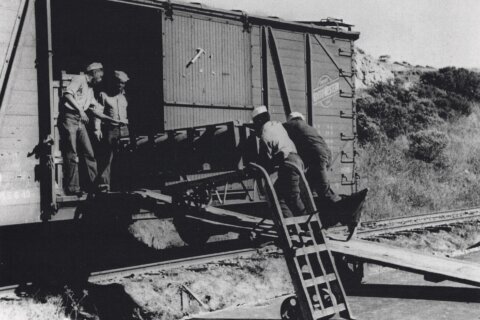Stagflation is an economic perfect storm that combines inflation, supply shortages and slower growth, along with a high unemployment rate. The 1970s is often referenced as a period of severe stagflation that brought higher jobless rates, soaring inflation and two economic recessions.
During the OPEC oil embargo in the 1970s, oil prices quadrupled and heavily contributed to stagflation. Rising prices for key commodities often trigger this economic event.
There are a few similarities between stagflation in the 1970s and the current economic climate. Inflation is elevated, supply shortages are still present in many industries, and interest rates remain relatively high. Although the latest consumer price index and producer price index readings have indicated that inflation is slowing, the Federal Reserve has made it clear that it’s in no rush to cut its benchmark interest rate as the central bank aims to bring inflation down to the 2% target rate.
[Sign up for stock news with our Invested newsletter.]
The economy has shown resilience, and things aren’t as bleak as they looked in 2022. Still, investors should know what to do if stagflation arrives. Having a plan in place would offer more insulation from the shocks of stagflation, if it were to happen. Here’s what you need to know about stagflation:
— What causes stagflation?
— Is the economy headed toward stagflation?
— How can investors protect against stagflation?
— Be greedy when others are fearful.
What Causes Stagflation?
Stagflation usually starts when commodity prices go up. Food and oil are two widely used commodities that can elevate costs for businesses and consumers. Rising oil prices, in particular, increase costs across the board because oil is associated with the transporting of products. Companies pay extra money for shipping and pass those costs on to consumers.
Higher costs on consumers can make them more cautious of their spending and result in companies facing slower demand and lower profit margins. Some businesses may have to lay off workers to remain afloat, further fueling stagflation in the process.
Stagflation is usually associated with lower productivity as companies have to make cuts and people hold back on their spending. As businesses fire talented workers, they end up with fewer employees who can produce products. Higher unemployment rates can put a weakened supply chain under more stress and lead to higher prices, even if consumers are reluctant to buy at current prices.
Once stagflation starts, it’s difficult to get out of it. Giacomo Di Pasquale, assistant professor of economics at the Wagner College’s Nicolais School of Business, explains the dilemma policymakers face when confronting stagflation: “Stagflation is particularly difficult for policymakers because traditional anti-inflationary tools (such as raising interest rates) can exacerbate unemployment, while initiatives to reduce unemployment (such as increasing public spending) can further accelerate inflation.”
Policymakers can find themselves between a rock and a hard place, having to choose between rampant inflation or higher unemployment rates. One scenario further reduces the value of fiat currencies that people work for while the other choice puts more people out of work.
Is the Economy Headed Toward Stagflation?
Stagflation became a major concern in 2022 as the U.S. grappled with inflation rates that reached 40-year highs. The Fed took decisive action and meaningfully hiked interest rates in a short amount of time.
Although inflation remains above the Fed’s 2% target, it has been decelerating. The consumer price index, or CPI, report for May showed that inflation slowed to 3.3% over the past 12 months. Di Pasquale mentions that low inflation is a key element of economies that aren’t experiencing stagflation. “If economic growth is strong, inflation is low and stable, and jobs are high, it is unlikely to enter stagflation,” he says.
A low unemployment rate indicates a strong economy with many employed workers. A reasonable unemployment rate hovers between 3% and 5%. Because the unemployment rate is currently 4%, more people would have to be out of work for stagflation to take hold. However, it has been ticking up, and it’s at a higher level than it has been in more than two years, according to the Labor Department.
There’s also a lack of commodity shocks at present. In fact, prices on several commodities have been falling in recent weeks. Oil prices have also been falling, another sign that the economy isn’t in stagflation. As of June 13, gas prices had dropped by 3 cents over the past week to an average of $3.46 per gallon in the U.S., according to AAA.
Some analysts believe oil will continue to fall, and one Citi analyst predicts oil will crash to sub-$60 levels from roughly $79 per barrel on June 14.
Even grocery prices recently fell for the first time in a year. While grocery prices aren’t going to fall to where they were a few years ago, keeping them flat for several months further reduces the likelihood of stagflation.
However, inflation can reaccelerate if interest rates go down too quickly. David Miller, chief investment officer and senior portfolio manager at Catalyst Funds, expressed concern that the latest 272,000 non-farm payroll number means interest rates are likely to remain elevated. “I see no way the Fed can go ahead and cut rates and maintain an inflation target remotely close to 2% given the strength in the economy, massive federal government deficits and strong employment,” Miller says.
A low unemployment number can keep stagflation out of the picture, but inflation remains a threat.
How Can Investors Protect Against Stagflation?
Stagflation can result in meaningful portfolio losses if investors aren’t prepared. Although stagflation is unlikely to occur in the current economic conditions, it’s good to have a contingency plan in place.
Diversifying your portfolio across stocks, real estate, gold and other assets can minimize your risk during stagflation. Real estate and gold can also help hedge against inflation.
As inflation increases, real estate and gold also rise in value because of their limited supply and their value to society. Other commodities also tend to perform well during stagflation, since high unemployment and high inflation can lead to erosion of the value of fiat currencies.
Growth stocks usually don’t fare well during stagflation. These stocks tend to have high valuations and depend on growing economies to achieve high revenue and earnings growth.
While consumer goods and utility stocks usually get left behind during bull markets, these same companies can generate steady returns and cash flow during stagflation. Investments that were volatile before stagflation will likely get more volatile and generate losses.
Di Pasquale mentions dividend stocks as viable choices for navigating stagflation. “Companies that pay high dividends can provide steady income even during recessions,” Di Pasquale says.
Investors can also consider Treasury inflation-protected securities, or TIPS, to protect themselves against inflation. These investments have variable principals that can go up or down during a term. If inflation increases, the principal will also increase. You will receive the higher amount at maturity if the TIPS principal increases over time. You’ll still get the original investment amount in the event of deflation.
Be Greedy When Others Are Fearful
Many stock market investors hit the panic button in 2022 when equities dropped amid record-breaking inflation and numerous rate hikes. While the stock market’s outlook appeared to be grim by the end of 2022, it actually presented a tremendous opportunity.
Stagflation can produce many negative headlines about corporations’ earnings reports and how some businesses are struggling to survive. Joseph Camberato, CEO of National Business Capital, encourages investors to zig when the market zags. “Stay alert for great opportunities. If you find one, take advantage of it because you might not know when the next one will come along,” he says.
During the worst of 2022, Facebook’s parent company, Meta Platforms Inc. (META), traded below $100 per share. Just a few years later, it’s trading above $500 per share. Many stocks are available at a discount during stagflation and other economic contractions.
If everyone seems to be bearish on the stock market, it can present an attractive long-term buying opportunity. Investors should be the most fearful when everyone seems to be bullish. This paradox has played itself out many times in the stock market. Recognizing how it has occurred in economic downturns like the Great Recession and the short-lived pandemic crash can make investors more prepared for opportunities that will emerge during stagflation.
More from U.S. News
How to Invest in Stocks for Beginners
What to Know About Investing in Penny Stocks
7 Best Copper Stocks to Buy Now
What Is Stagflation? originally appeared on usnews.com
Update 06/14/24: This story was previously published at an earlier date and has been updated with new information.







